Des Moines Heritage Trust releases 7 most endangered buildings list

Michael Crumb Jun 20, 2025 | 6:00 am
8 min read time
1,995 wordsAll Latest News, Real Estate and Development
Releasing a list of endangered buildings isn’t so much about identifying neglected and dilapidated buildings as much as it is about identifying opportunities for redevelopment, said Tim Waddell, president of the Des Moines Heritage Trust.
The nonprofit recently released its list of the seven most endangered buildings in Des Moines. The list creates awareness about buildings in the city that are at serious risk of demolition or irreversible decline.
The list is determined by public nominations that are winnowed down by the trust’s board to the seven most endangered.
“We’re sounding an alarm, yes, because we think there’s potential and … we’re hoping to spur on [redevelopment],” Waddell said. “You realize you have something there and it might be valuable. It might be important to retain and to make it something useful.”
Waddell said the Jefferson and Butler apartments in downtown Des Moines are on the list, and epitomize why the trust does its work.
The buildings have been vacant for a few years, and despite announced plans by the buildings’ owner, Krause+, they remain unoccupied without any redevelopment happening, he said.
“So we have two fully vacant buildings in downtown Des Moines and that makes us concerned,” he said. “Whenever a building is vacant, most of them on the list are vacant, they’re subject to vandalism because nobody is there. They are both attractive buildings we would like to see remain intact and we will continue to be concerned about them until something actually happens in a proactive way.”
In a statement given to the Business Record, Krause+ officials said the redevelopment plans for the Jefferson and Butler apartments are part of the Western Gateway district revitalization and align with Iowa Reinvestment Act district plans.
The Des Moines City Council signed off on the development in March 2025, according to the statement.
“Krause+ is currently formulating comprehensive plans, including permitting, zoning, and collaboration with key partners,” the statement read. “As the project progresses, Krause+ will evaluate redevelopment options, focusing on a balanced approach that integrates historic preservation, the creation of new housing and business opportunities, and enhanced community engagement.”
“As Krause Group, alongside Krause+, advances this transformative project, we will share the final plans for Butler and Jefferson as part of the overall redevelopment strategy for the district,” the statement read.
Other buildings included on this year’s list are two former schools and what is known as the oldest tavern in Iowa.
“We create the list of seven to shine a light and advocate for those buildings that we think are in trouble and may not survive,” Waddell said.
He said between 30 and 35 buildings have made the list over the seven years it has been published. Oftentimes, a building can make the list more than once.
He can only remember two or three buildings that have been razed. One of those is the Highland Park Apartments building that was demolished in 2023. More often, buildings that appear on the list result in successful stories of redevelopment, Waddell said.
“For example, the Ingersoll Theatre, which is now under renovation, was on the list for many years,” he said.
Sometimes, buildings come off the list because the reality sets in that they can’t be saved. That was the fate for the building on Hickman Road that housed George the Chili King.
“It’s a tough one because it’s an iconic drive-in restaurant,” Waddell said.
The diner made the endangered list in 2023 and 2024, and its iconic red-and-white sign was removed in 2024 with hopes of refurbishing it.
Waddell said the building isn’t in good shape and because of other factors, redevelopment appears unlikely.
“It was one that we didn’t see that it was survivable so we removed it,” he said.
When a building on the list is saved, it creates a great sense of reward, he said.
“We feel like in some small way we’ve contributed to it,” Waddell said. “I think we really can’t take credit for it in any way except that we are pointing out that there are potential buildings that a developer could use. When it happens, it’s just a wonderful feeling.”
Two particular areas where Waddell sees opportunity are the Hull Avenue Tavern and buildings on Southeast Sixth Street.
“Those are in commercial nodes that we think it’s important for developers to look at, not just the buildings on the list but the whole district, because we see those are potential Valley Junctions or Beaverdales and they have the potential to become something important,” he said.
Here is the list of this year’s seven most endangered buildings in Des Moines with descriptions provided by the Des Moines Heritage Trust:
Grant School: 1031 23rd St., Des Moines
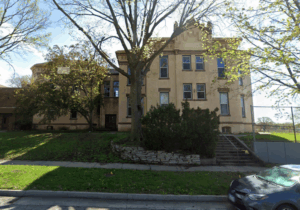
Grant School, built in 1885, is located just east of Drake Park. It was recently designated as a local landmark by the city of Des Moines. Grant School, named after Ulysses S. Grant, was built for the Des Moines Westside School District. It originally had six classrooms, but four more were added in 1895 and six more were added in 1910. The building has been owned by the New Life Center since 1978. Used as a religious center, a sanctuary was added in 1981 and is still in use. The original building is no longer being used and is not heated. Inspections have shown the building is still stable, and although it has landmark status, it is not protected from neglect or vandalism.
1370 23rd St. and 2312 Forest Ave., Des Moines

1370 23rd St. and 2312 Forest Ave. are connected by more than just common utilities. The house located at 1370 23rd St. has roots in the Victorian period with covered porches, stained glass and tower rooms, but does not appear in city records at that location until 1934. It was apparently moved to the location in 1933 by Richard D. Edward, a real estate agent who also built the commercial building on the west part of the lot that faced Forest. At that time, Forest Avenue was designated as U.S. Highway 6 in Des Moines which connected with Hickman Road via Beaver Avenue. A large commercial district developed from 19th to 34th streets included restaurants, professional offices, drug stores and grocery stores. The house was divided into several apartments and the commercial building to the west. It contained a second-story apartment where Edward lived until his death in 1959. The commercial property was occupied by many businesses over the years including, the Blue Willow restaurant, Cardinal Cleaners, Le Creperie, the Soup Kitchen, Whole Planet Café and most recently LaRosa Mexican restaurant.
2022, 2024, 2026 S.E. Sixth St., Des Moines (Sevastopol)
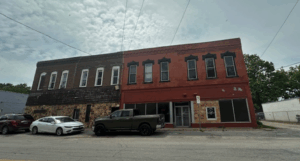
The buildings are adjacent on Southeast Sixth Street and were part of the original Main Street of the town of Sevastopol, which was incorporated in 1877 but its roots go back to 1855 as a settlement laid out by James Sherman just south of the Des Moines River. The building at 2026 was built in 1872 prior to the incorporation of Sevastopol. It is likely one of the oldest commercial buildings still standing in Des Moines. All three storefronts have second stories that have been used for apartments, fraternal organizations and community halls. The storefronts contained businesses such as Ray Brothers, Pidgeon’s Grocery, Hartford Variety Store and Capitol Coal Company. Sevastopol’s growth was spurred by two of the largest coal mines in Polk County including the Pioneer Mine owned by Wesley Redhead. Sevastopol was annexed by Des Moines in 1890, with its Main Street being changed to Southeast Sixth Street. The three storefronts were purchased by Invest DSM in 2024.
Chesterfield (Scott) School – 2501 Maury St., Des Moines
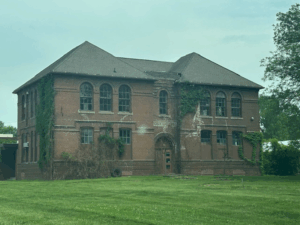
The town of Chesterfield began as a Des Moines suburb in 1882 after being a part of the William Lamb farm. Lamb came to the area in 1843 and grew many of the food crops for the soldiers located at Fort Des Moines 2 after contracting with Capt. James Allen. Chesterfield School was built around 1890, about the time Chesterfield was annexed by the city of Des Moines. Talks began around 1913 to add seventh and eighth grades to the school, and its name was changed to Scott in honor of W.A. Scott, who donated the land where the state Capitol is located. He is the only person buried on the Capitol grounds. The Maury Street location has been used for many purposes, including a streetcar turnaround. In 1951, 46 single-story concrete block houses were built to replace shacks that were located by the old city dump. The school has been used for food stamp distribution services and other community activities. The city bought the building in 1975 for $1 and built greenhouses in 2005 for the city horticultural department. Those are now closed and the building is no longer being used.
Butler Apartments (Gas Lamp): 1501 Grand Ave./510 15th St.
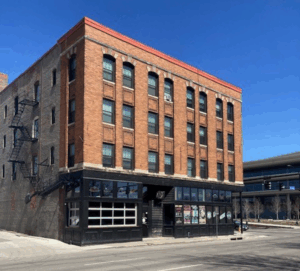
Nearly 120 years old, the four-story Butler Apartments/Gas Lamp Building was built in 1906. It had 16 apartments and two retail spaces. Of the Renaissance/Georgian style, it is a good example of the early 20th century design that combined commercial and residential spaces. The H.S. Chase Grocery Store and Meat Market were the original tenants of both of the retail sections facing Grand Avenue. The 16 apartments used the 15th Street address and entrance. Today, there are 23 apartments. For at least 50 years, the commercial bays have been home to music venues such as Blues on Grand, Vicky’s Pour House and Gas Lamp. The closing notice for Gas Lamp stated the building will be included in further redevelopment in the Gateway District, but Gas Lamp was not in that plan. Having passed through several owners in the last few years, a subsidiary of the former Kum & Go Corp. bought the building and the Jefferson Apartments in 2015 as plans were being made for their new headquarters just across the street to the east. The real estate arm of Krause Group, Krause+, has already successfully applied for $23 million in state tax incentives to redevelop the area.
The Jefferson Apartments: 1519 Grand Ave., Des Moines
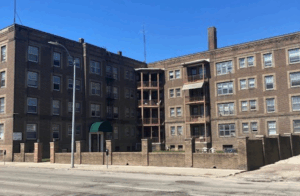
Built in 1915, the Jefferson Apartments building was purchased in 2015 by the Krause Group at the same time the Krause Group bought the Butler Apartments. A building permit for 52 apartments was requested by Harry Herndon Polk in April 1915. A café opened in the building in September of that year. The Bankers Life Company remodeled the building in 1938, converting the apartments into 72 smaller units. According to an August 2021 Des Moines Register article, there were plans to rehab the building. Tenants were told their leases would not be renewed so the extent of repairs could be better assessed. Although there are plans to rehab the building, demolition remains a possibility if repairs become too costly.
Hull Avenue Tavern (Snusville) – 834 Hull Ave., Des Moines
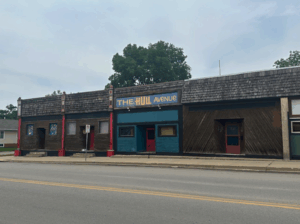
Often referred to as the oldest tavern in Des Moines, the Hull Avenue Tavern consists of three storefronts that have had various uses since the building was constructed around 1920. It was occupied by Gilhousen Grocery, Red Ball store, a plumber, a doctor and a jeweler until 1935. After Prohibition ended in 1933, the first tavern was the H.B. Inn, which opened 90 years ago. The name changed over the years to Cash’s Inn and then Charlie’s Inn until it became the Hull Avenue Tavern in 1960. The building was at the end of the streetcar line for that part of the city, and the area became a popular commercial district to shop or get a drink before going home. The area was known as Snusville. Speculation is that it received that name because of the high number of Danish and Swedish people who lived in the area around what is now Grand View University and because of the popular chewing tobacco that originated in Sweden. The Hull Avenue Tavern closed in 2024 and the future of the building is uncertain.

Michael Crumb
Michael Crumb is a senior staff writer at Business Record. He covers real estate and development and transportation.










